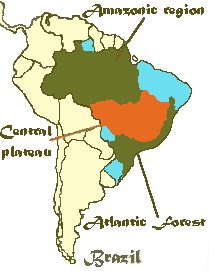Hideto Yamassaki's Home Page of Brazilian Orchids - Brazilian map in South America with orchid regions


In the south of this region the most famous species are Laelia purpurata, Catlleia intermedia, Cattleya forbesii, Brassavola tuberculata, Oncidium jonesianum, Oncidium flexuosum, Oncidium concolor, Oncidium sarcodes. They grow near the sea over small trees and rocks or deep in the forest everywhere, from the ground to the top of the highest trees. There are hundreds of genus and species. In this region are the states of Rio Grande do Sul, Santa Catarina and Parana, from the south to the north.
In the middle, one of the richest regions in orchid species in the world, the most famous are Cattleya warnerii, Cattleya loddigesii, Laelia lobata, Laelia crispa, Laelia tenebrosa, Laelia pumila, Laelia harpophylla, Laelia perrinii, Cattleya tigrina, Stanhopea graveolens, Miltonia spectabilis, Oncidium gardnerii, Oncidium forbesii, Oncidium ciliatum. Growth environments vary from the beach sands to the deep forest and naked tall rocks in the mountains. Cattleya elongata is an example of orchid that grows in this last environment. In these regions are the states of Minas Gerais, Sao Paulo, Rio de Janeiro and Espirito Santo. In the highlands of the state of Minas Gerais, between the Atlantic Forest and the Central Plateau, the main species are the small rupestric Laelias like Laelia rupestris, Laelia flava, Laelia crispata and the famous red Sophronitis coccinea that gives its color to so many hybrids. These last orchids may face temperatures near 0ºC (32ºF) in the winter.
To the north, Cattleya labiata, Cattleya ametistoglossa, Cattleya tigrina are the most famous. The states of Bahia, Sergipe, Alagoas, Pernambuco, Paraiba, Rio Grande do Norte, Ceara and Piaui are in this region. The environment, as we go to the north, gets dryer and dryer and finally orchids can be found only in the valleys of perenial rivers in the inner land mountains. Cattleya labiata, originally described by Lindley, was missed for more than 60 years because the orchid collectors did not mentioned their collecting sites, the first of them who found the species died and nobody else remembered of looking for orchids in the dry areas of Northeast Brazil. Back to the top.
The Central plateau is rich in species of the genuses Catasetum, Cyrtopodium and Galeandra, and also has Cattleya walkeriana, Cattleya nobilior, Thricocentrum albo-coccineum, Bletia catenulata. The States of these regions are Mato Grosso do Sul, Goias, Minas Gerais. The vegetation is called cerrado and is similar to the african savana. Orchids grow in the blotchs of forest near the rivers or in the palm trees in the middle of the lands. It rains from October to Mars in this region and it is dry the rest of the year. Temperatures vary from 15 Celsius degrees in the wet January to 35 Celcius degrees in the hot and dry July. Orchids of these region requires a long time of rest, without water. Back to the top.
The Amazonic region is huge and has many different environments. States are Rondonia, Acre, Amazonas, Roraima, Para, Amapa, Tocantins and Maranhao. The most famous species are Acacallis cyanea, Cattleya luteola, Cattleya violacea, Cattleya araguaiensis, Cattleya eldorado, Oncidium lanceanum, Oncidium nanum. It rains from October to March and the humidity is warranted in the rest of the year because of the respiration of the forest and the huge rivers that cross the region. It is hot almost all the year, temperatures from 15 to 38 Celsius degrees. Orchids of this region require warmer ambients to grow well. Back to the top.


